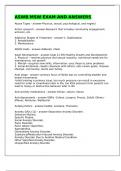ASWB MSW EXAM AND ANSWERS
Abuse Types - answer-Physical, sexual, psychological, and neglect
Action research - answer-Research that includes community engagement,
activism, etc.
Addiction Stages of Treatment - answer-1. Stabilization
2. Rehabilitation
3. Maintenance
ADHD meds - answer-Adderall, ritalin
Adult Development - answer-(Age 21-39) Healthy Growth and Development.
1. Physical —reaches physical and sexual maturity, nutritional needs are for
maintenance, not growth
2. Mental—acquires new skills, information; uses these to solve problems
3. Social-Emotional—Seeks closeness with others; sets career goals; chooses
lifestyle, community; starts own family.
Anal stage - answer--primary focus of libido was on controlling bladder and
bowel movements
-toilet training is primary issue, too much pressure can result in excessive
need for order or cleanliness later in life, too little pressure from parents can
lead to messy or destructive behavior later in life
Anti-anxiety medications - answer-Ativan, valium, Xanax
Anti-depressants - answer-SSRIs -Celexa, Lexapro, Proxac, Zoloft, Others -
Effexor, Remeron, Wellbutrin
Antipsychotics - answer-Haldol, Loxitane, Thorazine
Anxiety D/Os (12) - answer-Separation Anxiety Disorder,
Selective Mutism,
Specific Phobia,
Social Anxiety Disorder,
Panic Disorder,
Panic Attack (Specifier),
Agoraphobia,
Generalized Anxiety Disorder,
Substance/Medication-Induced Anxiety Disorder,
Anxiety Disorder Due to Another Medical Condition,
Other Specified Anxiety Disorder,
Unspecified Anxiety Disorder
,Asceticism - answer-Rigor and self-denial
-refuse to eat or sleep until project complete
-refuse pleasure to cope with tension and desire
Autonomy vs Shame & Doubt - answer-Between the ages of 1 and 3, children
begin to assert their independence by walking away from their mother. If
encouraged it fosters independence, if criticized it leads to feeling unable to
survive and over dependence on parent.
Basic Human Needs (Maslow's Hierarchy) - answer-
Beck Depression Inventory - answer-21 items to measure depression
Behaviorist Theory - answer-(Pavlov, Skinner)—learning is viewed through
change in behavior and the stimuli in the external environment are the locus
of learning. Social workers aim to change the external environment in order
to bring about desired change.
Biological section assessment - answer-A client's medical history,
developmental history, current medications, substance abuse history, and
family history of medical illnesses.
Biopsychosocial History - answer-Provides information on the
current/presenting issue or issues; a client's past and present physical
health, including developmental milestones; a client's emotional functioning;
educational or vocational background
Bipolar I Disorder - answer-1 manic episode in lifetime
Manic Episode
A. A distinct period of abnormally and persistently elevated, expansive, or
irritable mood and abnormally and persistently increased goal-directed
activity or energy, lasting at least 1 week and present most of the day
B. During the period of mood disturbance and increased energy or activity,
three (or more) of the following symptoms:
1. Inflated self-esteem or grandiosity. 2. Decreased need for sleep (e.g., feels
rested after only 3 hours of sleep). 3. More talkative than usual or pressure
to keep talking. 4. Flight of ideas or subjective experience that thoughts are
racing. 5. Distractibility (i.e., attention too easily drawn to unimportant or
irrelevant external stimuli), as reported or observed. 6. Increase in goal-
directed activity (either socially, at work or school, or sexually) or
psychomotor agitation (i.e., purposeless non-goal-directed activity). 7.
Excessive involvement in activities that have a high potential for painful
consequences (e.g., engaging in unrestrained buying sprees, sexual
indiscretions, or foolish business investments).
, C. The mood disturbance is sufficiently severe to cause marked impairment
in social or occupational functioning
C. The mood disturbance is sufficiently severe to cause marked impairment
in social or occupational functioning
1 depressed episode during 2 week period.
Major Depression A. Five (or more) of the following symptoms have been
present
1. Depressed mood most of the day, nearly every day
2. Markedly diminished interest or pleasure in all, or almost all, activities
most of the day
3. Significant weight loss when not dieting or weight gain
4. Insomnia or hypersomnia nearly every day.
5. Psychomotor agitation or retardation
6. Fatigue or loss of energy
7. Feelings of worthlessness or excessive or inappropriate guilt 8. Diminish
Bipolar II Disorder - answer-1 hypomanic episode
A. A distinct period of abnormally and persistently elevated, expansive, or
irritable mood and abnormally and persistently increased activity or energy,
lasting at least 4 consecutive days and present most of the day, nearly every
day.
B. During the period of mood disturbance and increased energy and activity,
three (or more) of the following symptoms have persisted: 1. Inflated self-
esteem or grandiosity. 2. Decreased need for sleep (e.g., feels rested after
only 3 hours of sleep). 3. More talkative than usual or pressure to keep
talking.4. Flight of ideas or subjective experience that thoughts are racing. 5.
Distractibility (i.e., attention too easily drawn to unimportant or irrelevant
external stimuli), as reported or obsen/ed. 6. Increase in goal-directed
activity (either socially, at work or school, or sexually) or psychomotor
agitation. 7. Excessive involvement in activities that have a high potential for
painful consequences (e.g., engaging in unrestrained buying sprees, sexual
indiscretions, or foolish business investments).
C. The episode is associated with an unequivocal change in functioning that
is uncharacteristic of the individual when not symptomatic. D. The
disturbance in mood and the change in functioning are observable by others.
E. The episode is not severe enough to cause marked impairment in social or
occupational functioning or to necessitate hospitalization. If there are
psychotic features, the episode is, by definition, manic. F. The episode is not
attributable to the physiological effects of a substance (e.g., a drug of abuse,
a medication or other treatment).
1 depressed episode.
Bipolar related D/Os (7) - answer-Bipolar I, Bipolar II, cyclothymic d/o
Bowen Emotional Triangle - answer-3 person system, smallest stable
relationship, forms when two people experience tension




